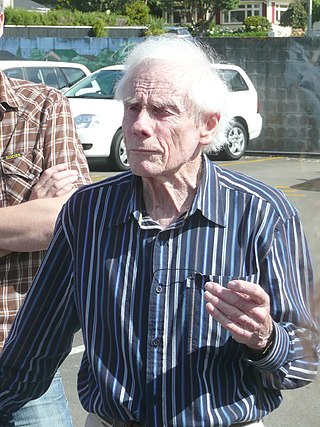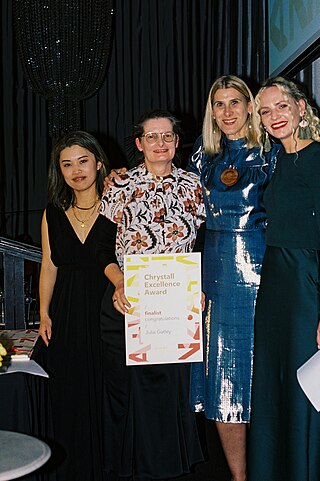
Sir Frederick Miles Warren was a New Zealand architect. He apprenticed under Cecil Wood before studying architecture at the University of Auckland, eventually working at the London County Council where he was exposed to British New Brutalism. Upon returning to Christchurch, and forming the practice Warren and Mahoney, he was instrumental in developing the "Christchurch School" of architecture, an intersection between the truth-to-materials and structural expression that characterised Brutalism, and the low-key, Scandinavian and Japanese commitment to "straightforwardness". He retired from Warren and Mahoney in 1994 but continued to consult as an architect and maintain his historic home and garden at Ohinetahi.

William Ball Sutch was a New Zealand economist, historian, writer, public servant, and public intellectual. He was suspected of being a Soviet spy and in 1974, he was charged with trying to pass New Zealand Government information to the Soviet Union. He was acquitted, an outcome that was the subject of much debate since then. Although there were subsequent disclosures from the KGB which indicated that he may have been a spy, no definitive proof that he was has ever been uncovered.

Te Ngākau Civic Square is a public square in central Wellington, New Zealand, between the Wellington central business district to the north and the Te Aro entertainment district to the south. The square is bounded by Jervois Quay, Harris Street, Victoria Street and Wakefield Street
The Architectural Centre Inc is a nonprofit organization in Wellington, New Zealand, for architects and laypeople with an interest in architecture which offers lectures, site visits, tours and exhibitions.
Architecture of New Zealand is the built environment of regions, cities and towns of New Zealand.

Stanley William Toomath was a New Zealand architect who practised mainly in Wellington. He was a founding member of the Architectural Group in Auckland in 1946, a life member of the Wellington Architectural Centre and a Fellow of the New Zealand Institute of Architects. Both the founding of the Group and the Architectural Centre were important factors in New Zealand's modernist architectural history.
James Albert Beard was a New Zealand architect, town planner, and landscape architect.

Edmund Anscombe was one of the most important figures to shape the architectural and urban fabric of New Zealand. He was important, not only because of the prolific nature of his practice and the quality of his work, but also because of the range and the scale of his built and speculative projects. These extended from conventional essays to monumental urban schemes informed by his international travel, especially in America. His influence was specifically felt in Dunedin, Wellington, and the rebuild of Hastings following the 1931 Hawkes Bay Earthquake. He also realised projects in Alexandra, Invercargill, Palmerston, Palmerston North, Rotorua, Waimate North and Wanaka. His key works include the 1925–26 New Zealand and South Seas International Exhibition, the 1940 New Zealand Centennial Exhibition, the Herd Street Post and Telegraph building, Anscombe Flats, the Empire Deluxe theatre and his work on the clocktower complex – including specifically the Archway Building and Marama Hall – effectively re-conceiving the design of the University of Otago's historical core.(University of Otago Clocktower complex). His sister is painter Eliza Anscombe
Anthony Lawrance Treadwell was an early member of the Wellington Architectural Centre and an accomplished modernist architect, architectural educator and painter. His architectural work has been published in numerous articles in New Zealand Home and Building, the Arts Year Book, the Journal of the N.Z.I.A. and the Wellington Architectural Centre's Design Review.

Te Kāhui Whaihanga New Zealand Institute of Architects (NZIA) is a membership-based professional organisation that represents 90 per cent of all registered architects in New Zealand, and promotes architecture that enhances the New Zealand living environment.
Ernst Anton Plischke was an Austrian-New Zealand modernist architect, town planner and furniture designer whose work is well known throughout Europe and New Zealand.

Dixon Street Flats is a historic building in Wellington, New Zealand designed by the Housing Division of the Ministry of Works.

Elizabeth Margaret Farrelly, is a Sydney-based author, architecture critic, essayist, columnist and speaker who was born in New Zealand but later became an Australian citizen. She has contributed to current debates about aesthetics and ethics; design, public art and architecture; urban and natural environments; society and politics, including criticism of the treatment of Julian Assange. Profiles of her have appeared in the New Zealand Architect, Urbis, The Australian Financial Review, the Australian Architectural Review, and Australian Geographic.
Francis Gordon Wilson was an Australian born, New Zealand architect. Wilson oversaw the design of New Zealand’s state housing programme from the 1930s onwards. He was the New Zealand Government Architect at the time of his death.
Karen Burns is an Australian architectural historian and theorist. She is currently a senior lecturer in architecture at the Melbourne School of Design, University of Melbourne.

David George Porter was a New Zealand architect, company director and politician. He was a Wellington City Councillor and Deputy-Mayor from 1970 to 1971.

Judith Ngaire Maud Pickard was a New Zealand abstract painter, librarian and advocate for women's rights.
The Design Guild, also known as the Auckland Design Guild, formed in Auckland in June 1949 for the promotion of good design, was a short-lived professional body for designers in New Zealand.

Julia Gatley is an architect, academic, architectural historian and author from New Zealand. As a historian and author Gatley has contributed knowledge about New Zealand's built landscape. She is the author of the book Athfield Architects about one of New Zealand's most well-known contemporary architects Ian Athfield and is a regular commentator about New Zealand's architectural history.
Anna Plischke was a landscape designer trained in Vienna, who practised in New Zealand. She introduced modernist ideas of design to the built environment and architectural practice.











